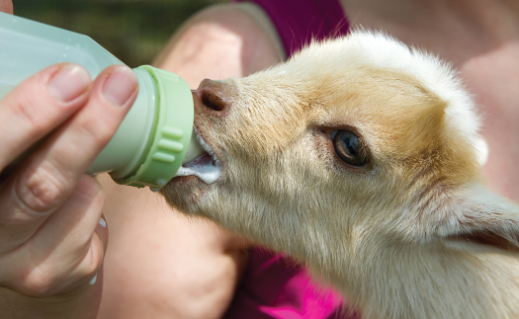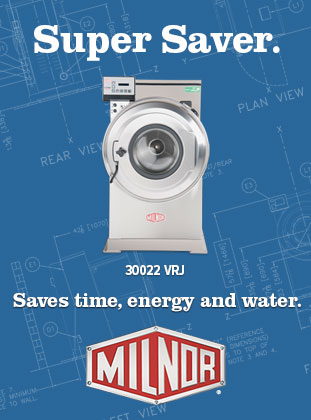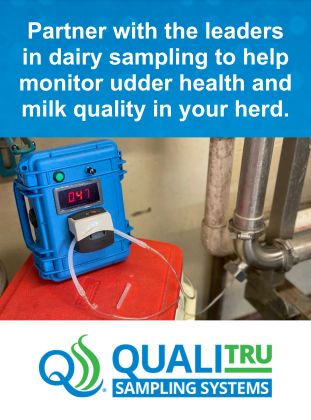Feeding Goat Kids

By Michelle Buckley, DVM, MS – Iowa State Universituy Extension and Outreach Dairy Field Specialist.
When it comes to feeding kids, producers have options and the best option is not a one size fits all solution. The ultimate markers of success are healthy kids with low death losses. Each method of kid-rearing requires careful consideration by producers to determine the technique that is most likely to be successful on their operation. This article will focus on milk (or milk replacer) feeding of kids from two days of age to weaning. Colostrum management was covered in the January 2023 issue and will not be discussed here.
Dam raising
Dam raising youngstock occurs more commonly with dairy goats than dairy cattle. The low input required for this method of raising replacements makes it enticing, especially for non-commercial producers. However, the convenience of dam raising kids may be outweighed by the potential health challenges it presents since diseases like Johnes and Caprine Arthritis Encephalitis are commonly transmitted through nursing. J.R. Robertson published a study in the Journal of Dairy Science in 1998 demonstrating that mastitis pathogens like Staph. aureus are passed to calves through non-pasteurized milk. Though this research has not been replicated in goats, many producers believe that allowing kids to nurse puts first fresheners at a higher risk of developing mastitis after kidding for this reason. As a result of these health challenges, along with the economic incentive of selling milk rather than using it to feed kids, many producers seek alternatives to dam rearing.
Milk feeding
If feeding milk is still more economical for your operation than using a milk replacer product, fear not! While this method of feeding kids is more labor-intensive than dam rearing there is a way to mitigate concerns of pathogen transmission in milk. The first step to providing high quality milk to your kids is to cool the milk as quickly as possible after it is collected to prevent multiplication of any bacteria that may be present. Feeding waste milk, hospital milk, or milk from does that have been treated with antibiotics is not recommended. Once milk has been collected from does and cooled, pasteurization can be used to kill bacteria in the milk. If done properly, this process will not detract from the nutritional value of the milk.
Collecting periodic pre-and post-pasteurization milk samples for culture is recommended to monitor how effective your pasteurizer is. Commercial pasteurizers are available in all sizes to facilitate the pasteurization process by maintaining the appropriate temperature for the prescribed duration. Refer to the October 2021 issue of American Dairymen for more insights into the at-home pasteurization process. After pasteurization is complete, milk should be cooled rapidly to 40℉, labeled with the date of pasteurization and stored in a covered container in the refrigerator for up to two weeks.
Milk replacer
When selecting a milk replacer for goat kids, achieving appropriate nutritional value is paramount. Dr. Robert Van Saun of Penn State University Extension recommends 15-16% milk solids as a minimum for adequate nutrition while Dr. Andrea Mongini of M&M Dairy Practice has seen problems with abomasal bloat with diets that exceed 19% solids. Preparation and presentation of the product is also of great importance as improper preparation and unappetizing presentation can affect the nutritional value of the product or cause kids to refuse to drink it. Milk replacer that is mixed with excessively hot water will result in denatured proteins and congealed fat by the time it reaches kids and may be too hot for them to consume safely. On the other hand, using cold water to mix replacer can prevent the powder from dissolving completely and will result in a clumpy, cold product that is altogether unappetizing to kids. Using an instant read digital thermometer to assess water temperature before and during bottle preparation can help to mitigate these issues. Also, be aware that outdoor temperatures that are significantly different from the liquid in the bottle can affect the temperature of the product by the time it reaches kids if it needs to be transported outside between mixing and feeding. Using an insulated tub or cooler with hot packs to transport bottles can help mitigate this temperature fluctuation. Milk replacer should be fed within one hour of mixing and any unfinished milk should be removed within an hour of feeding. Leaving milk out for prolonged periods allows for bacterial growth and milk spoilage. Unfinished milk can also be a sign of a health problem.
Cleaning equipment
The importance of cleanliness in bottle raising kids cannot be overstated. Use of bleach is not recommended for cleaning feeding equipment as it is harsh on rubber resulting in microcracks that can harbor bacteria. Bleach also does not kill all pathogens of concern (i.e. coccidia). All equipment that is used for feeding should be cleaned and dried after every meal.
Dr. Mongini recommends cleaning free choice feeding systems hourly but every six hours is the bare minimum.
At the beginning of each wash, rinse all equipment with clean, warm (100-110℉) water. Cooler water allows fat to deposit on equipment and water hotter than 120℉ will create protein films. Next, wash all equipment with hot (120-135℉) soapy water. The alkaline detergent breaks up any remaining fat droplets while chlorine helps to remove any remaining proteins.
Rinse equipment thoroughly with warm (100-110℉) water again and dry equipment thoroughly after washing. Supplies can be left in a clean area to dry between feedings. Nipples should be replaced every two months and equipment with visible residues or cracks should be replaced immediately.
As always, there are many ways of accomplishing the goal of raising healthy dairy kids. Which system works best depends on the producer’s goals, available infrastructure and labor, size of the operation, and current health challenges within the herd. There are also many ways that feeding kids can lead to health challenges and frequent evaluation is necessary to identify problems early. If you are interested in reevaluating your kid nutrition or have concerns about the efficacy of your current kid-rearing program, contacting your local veterinarian, extension agent, or nutritionist is a great place to start. If you would like to find a veterinarian in your area that works on small ruminants, visit the American Association of Small Ruminant Practitioner’s website at AASRP.org and click on ‘Find a Veterinarian’.


